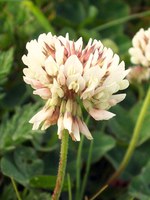Dakota Gardener: Would You Plant a Bee Lawn?
(Click an image below to view a high-resolution image that can be downloaded)
By Esther E. McGinnis, Horticulturist
NDSU Extension
When I was growing up, my father wanted to have the perfect, weed-free lawn. I remember him spending hours mowing, fertilizing and spraying 2,4-D.
The lawn was good enough to win the local newspaper’s yard of the week competition. However, my father was never successful in eradicating the white clover in our backyard. I was fascinated by the bumble bees that visited the white blossoms.
Fast forward to 2022. In the years since my childhood, the turf industry has developed more effective lawn herbicides for residential yards. In my neighborhood, I can’t think of a single lawn that has white clover. While the lawns are all perfectly green, there is something missing—bees.
We’ve been conditioned by lawn companies to think that a healthy lawn is synonymous with a solid green carpet. In reality, a green monoculture is like a desert for our pollinators. Pollinators need flowers that produce nectar and pollen to survive. Our bee populations have been shrinking because there are fewer flowers in lawns, fields and ditches.
What we do in our yard matters by virtue of the large area that lawns occupy. Turfgrass is the single largest irrigated crop in the United States. Collectively, Americans grow enough turfgrass to equal the land area of Texas. This area is just slightly less than U.S. wheat acreage.
Turfgrass researchers are now advocating that homeowners plant special bee lawns to provide pollinator habitat. These are special turfgrass mixtures that contain fine fescues and short-growing flowering species like white clover that will provide nectar and pollen for pollinators. For example, the University of Minnesota is recommending the incorporation of white clover, creeping thyme and self-heal into turfgrass.
The psychological barriers to planting a bee lawn can be daunting even in a horticulturist’s household. When I mentioned planting a bee lawn, my husband was hesitant. What will the neighbors think? Will the clover make the lawn look unkempt? Will we still be able to spray herbicide to keep the dandelions under control?
Many individuals will have concerns and questions. That’s why North Dakota State University is trialing bee lawns in the Horticultural Research and Demonstration Garden on campus. Three separate bee lawn mixes were sowed last summer and will be available for the public to visit this summer along with other turfgrass plots.
I am going to trial a small patch of bee lawn in our backyard. If you are hesitant like my husband, the key is to start small. We are going to plant a 100 square foot patch and evaluate how it does.
We like our neighbors and will communicate our objectives to them. If one of our neighbors has a bee allergy, we will be considerate. One of our neighbors really does prize the perfect green lawn. Therefore, it would probably be better to locate our bee lawn on the other side of our yard.
Bee lawns are a major paradigm shift. We’ll start small and be respectful of our neighbors.
For more information about gardening, contact your local NDSU Extension agent. Find the Extension office for your county at https://www.ag.ndsu.edu/extension/directory/counties.
NDSU Agriculture Communication – Feb. 1, 2022
Source: Esther McGinnis, 701-231-7971, esther.mcginnis@ndsu.edu
Editor: Kelli Anderson, 701-231-6136, kelli.c.anderson@ndsu.edu




